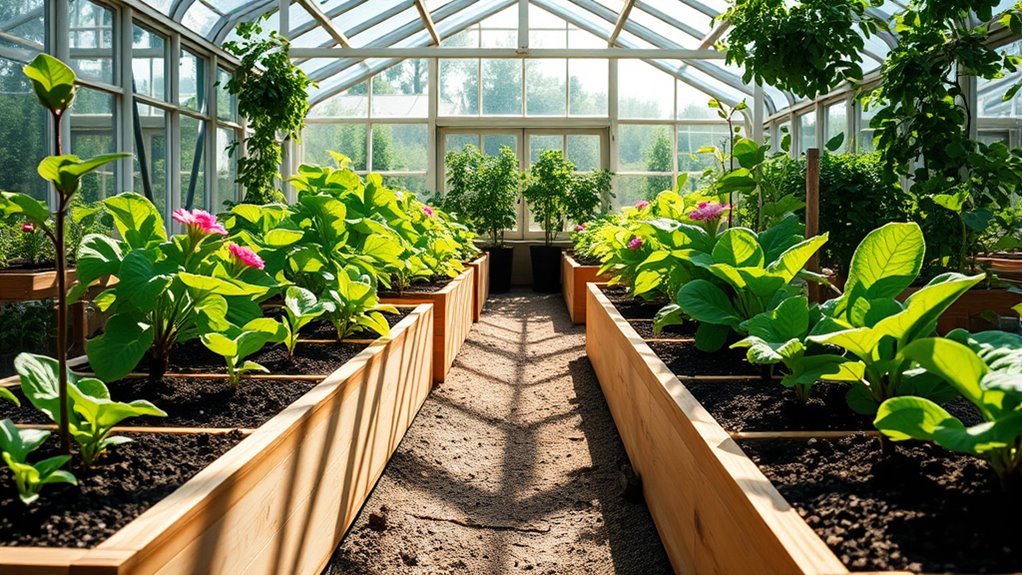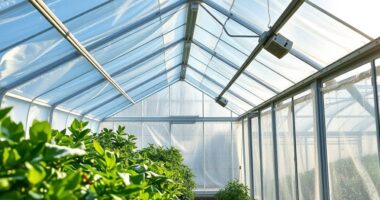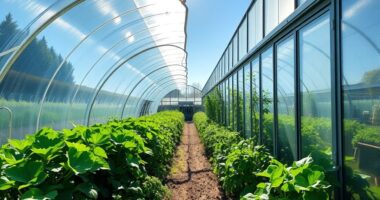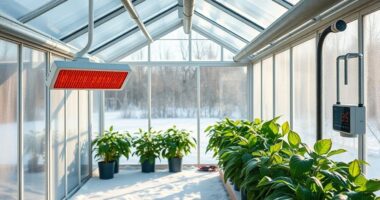Creating raised beds inside your greenhouse can significantly enhance your gardening experience. They improve drainage, allow for customized soil mixes, and protect plants from pests. Start by choosing durable materials like cedar or corrugated steel. Design your layout for optimal sunlight and accessibility, ensuring beds are easy to maintain. Don’t forget to select the right soil mix, combining topsoil and compost for the best growth. Discover more tips and techniques as you continue your gardening journey!
Key Takeaways
- Choose durable materials like cedar or recycled plastic to construct long-lasting raised beds in your greenhouse.
- Design beds to maximize sunlight and ensure easy access for maintenance and harvesting tasks.
- Use a soil mix of 60% topsoil and 30% compost to promote healthy plant growth in raised beds.
- Position taller plants away from windows to prevent shading and optimize growth conditions.
- Incorporate pathways and functional features like tables to enhance usability and organization within the greenhouse.
Benefits of Raised Beds in a Greenhouse
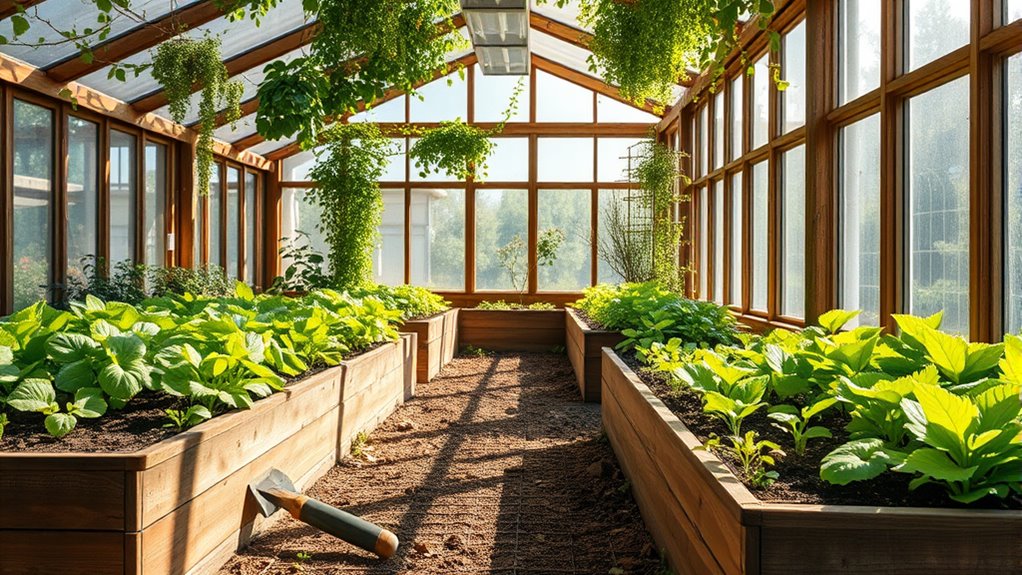
When you choose raised beds for your greenhouse, you’ll quickly discover a host of benefits that enhance your gardening experience.
Improved drainage is one of the biggest advantages; it reduces the risk of overwatering and root rot while promoting healthier root systems.
Improved drainage in raised beds significantly lowers the risk of overwatering, ensuring healthier root systems for thriving plants.
With raised beds, you can customize soil mixes tailored to your specific crops, enhancing nutrient absorption and overall plant health.
Plus, their elevated design protects your plants from ground-dwelling pests and minimizes soil-borne diseases.
You’ll also notice that raised beds warm up faster in spring, allowing for earlier planting.
This structure not only optimizes growing conditions but also boosts productivity, making gardening tasks like planting and harvesting more efficient and enjoyable.
Choosing the Right Materials for Your Raised Beds
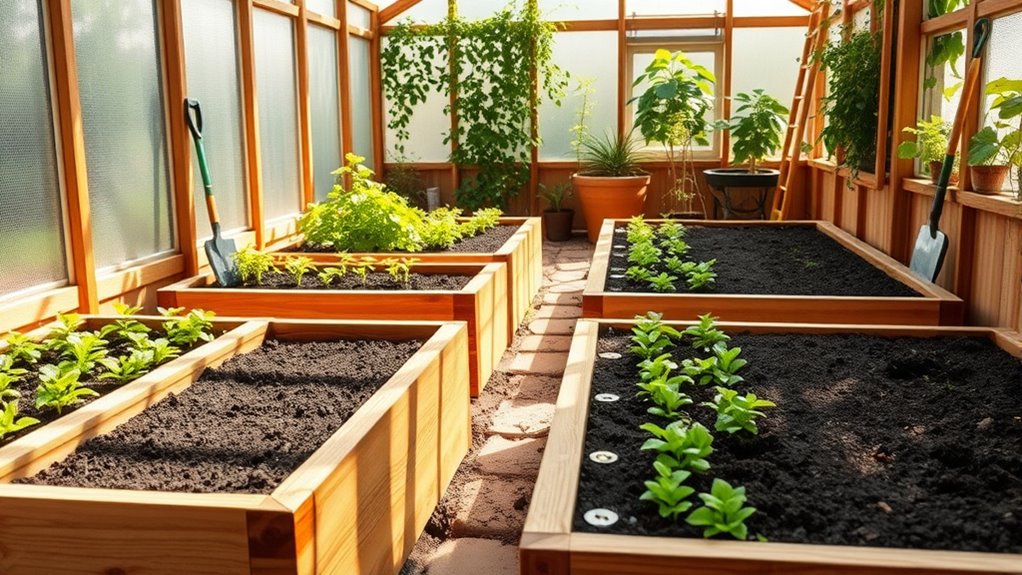
Raised beds offer numerous advantages for your greenhouse, but selecting the right materials is key to maximizing their benefits.
Durable options like cedar wood resist rot and pests, making it a popular choice. If you prefer eco-friendly materials, consider recycled plastic, which is also resistant to decay.
Corrugated steel provides a modern, sturdy option, while cinder blocks create permanent beds, though they can be heavy and pricier. For a natural touch, adobe stucco is durable but labor-intensive.
Keep cost and availability in mind—wood’s generally inexpensive, while recycled materials can be budget-friendly. Additionally, using local sources can help reduce your carbon footprint and enhance your greenhouse’s aesthetic appeal with materials that fit your style.
Designing Your Raised Bed Layout
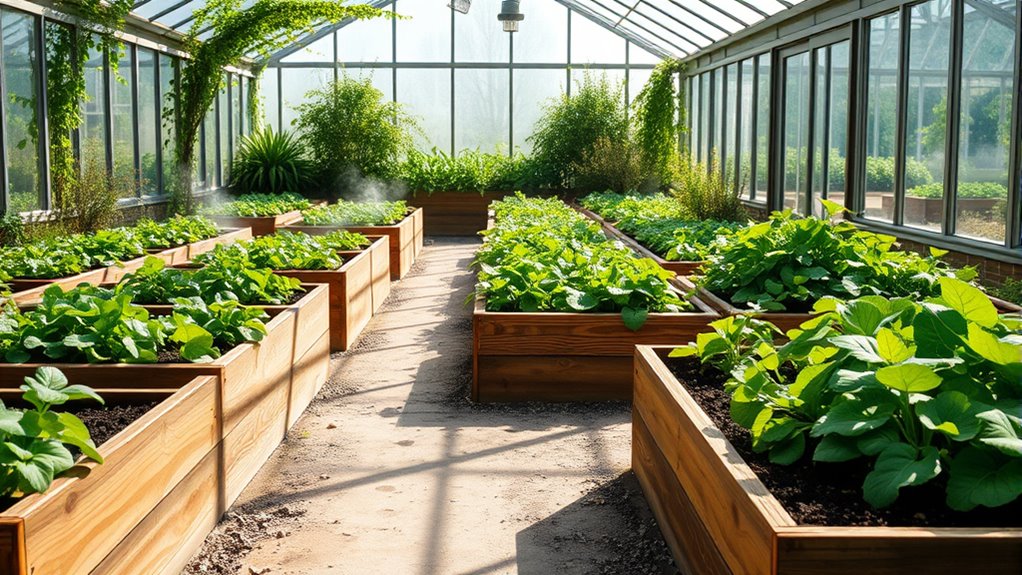
Designing an efficient layout for your raised beds can significantly enhance your greenhouse gardening experience.
First, position your beds to maximize sunlight exposure, taking into account window locations and seasonal sun angles. Keep accessibility in mind; aim for beds no wider than 4 feet if accessible from both sides, or 3 feet if from one.
Position your raised beds to maximize sunlight and ensure easy access for optimal gardening success.
Consider finger-style beds for better space utilization and easy navigation. Place shorter plants near windows and taller ones further back to ensure optimal growth.
Don’t forget to plan pathways wide enough for maintenance. Finally, incorporate additional features like a bistro table or extra growing areas to make the most of your greenhouse space while ensuring a functional and inviting environment. Additionally, ensuring proper butter quality can help you create a cozy atmosphere for your gardening activities.
Constructing Your Raised Beds

Constructing your raised beds involves selecting the right materials and ensuring a sturdy frame that will support your plants for years to come. You can choose from wood, metal, or plastic for your frame.
Assemble the frame using wooden studs or metal corners, reinforcing them for stability. Aim for ergonomic heights to minimize bending while planting and tending to your garden.
When building the sides, consider durable options like corrugated steel or wood planks, and attach them securely with screws or nails. Ensure the materials don’t absorb heat or cold to maintain a consistent temperature.
Finally, finish your frame with additional materials for a smooth surface, enhancing both functionality and aesthetic appeal in your greenhouse.
Selecting the Best Soil for Raised Beds
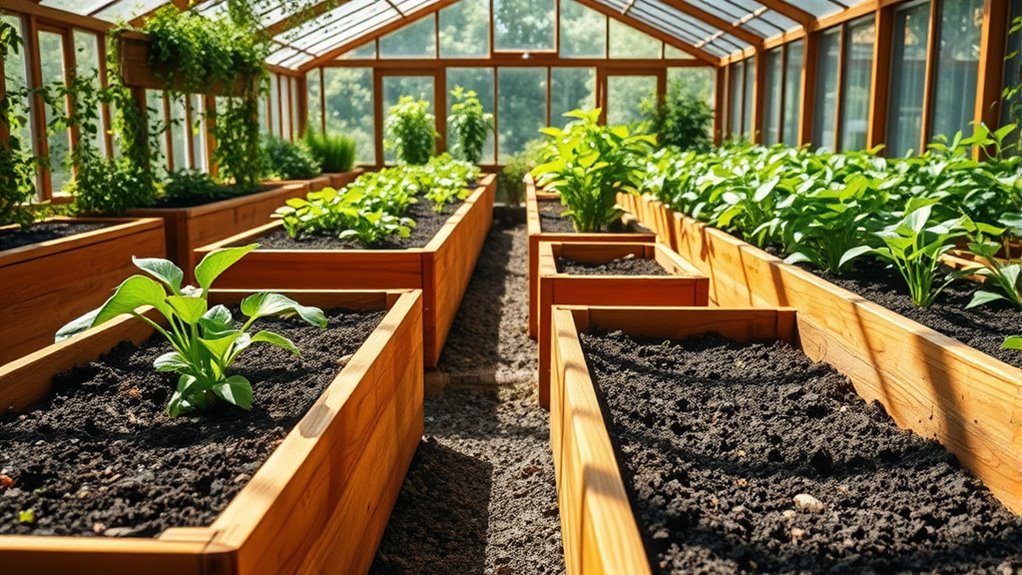
Choosing the right soil for your raised beds is crucial for nurturing healthy plants. Start with a solid base of topsoil, making up about 60% of your mix, as it provides structure and essential nutrients.
Add 30% compost for nutrient supply and improved soil structure. If you want a balanced recipe, consider a 50/50 blend of topsoil and compost.
Incorporate 30% compost for enhanced nutrients and structure, or opt for a balanced 50/50 mix of topsoil and compost.
You can also customize your mix by incorporating organic matter like worm castings or peat moss for moisture retention.
Don’t forget to check the pH balance, aiming for a range of 6.0 to 7.0 for optimal growth. Regular soil testing will help you maintain the right conditions for thriving plants throughout the growing season.
Planting and Maintaining Your Raised Beds
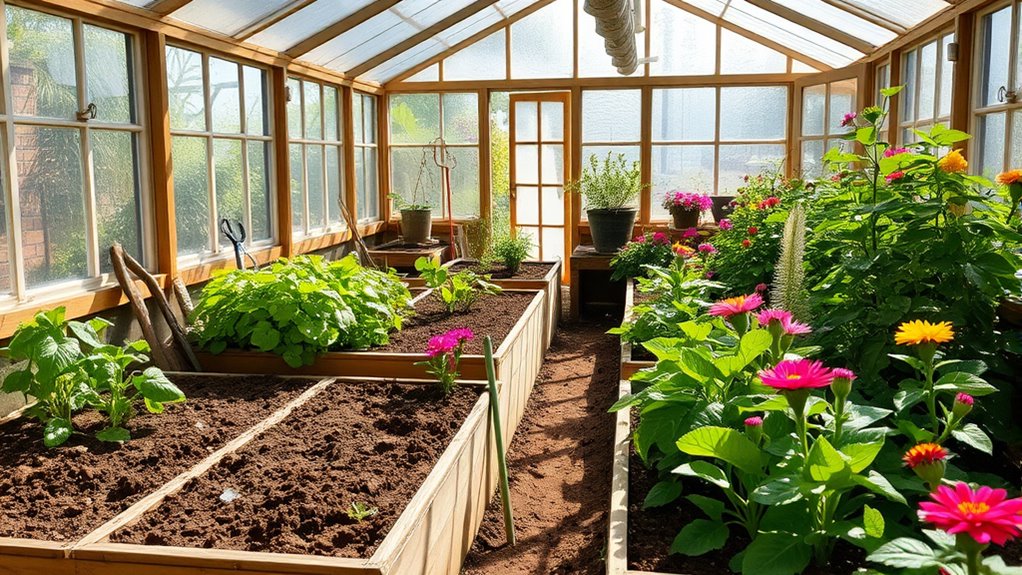
Once you’ve established your raised beds, it’s time to focus on planting and maintaining them for optimal growth.
Start by selecting crops that thrive in controlled environments, like tomatoes and cucumbers. Plant them closely together but ensure good air circulation. Rotate your crops seasonally to keep the soil healthy and use companion planting to deter pests.
Maintain optimal conditions by controlling temperature and humidity, and ensure proper ventilation. Water deeply but less frequently to encourage strong root systems, and monitor soil moisture to prevent overwatering.
Mulching can help retain moisture and suppress weeds. Regularly inspect your plants for pests and diseases, and adjust your strategies seasonally to keep your greenhouse thriving year-round.
Enhancing the Aesthetics of Your Greenhouse With Raised Beds
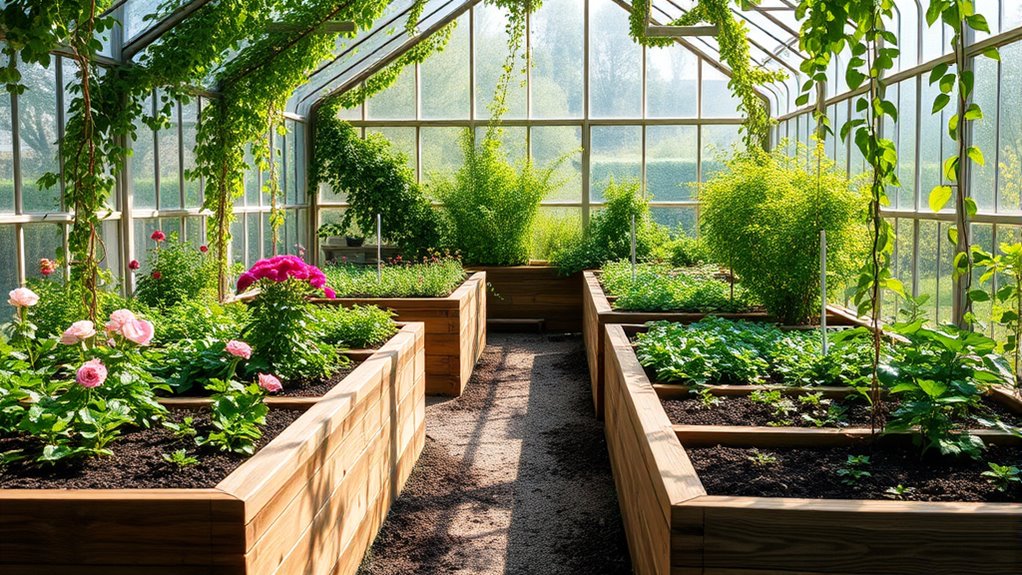
While enhancing the aesthetics of your greenhouse, raised beds can play a pivotal role in creating an inviting and functional space. You can choose from materials like wooden or aluminium beds, each offering a unique look and durability. Optimize your layout by positioning beds for maximum sunlight and easy access, ensuring maintenance is a breeze. Chia seeds can be a fantastic addition to your raised beds, as they are nutrient-dense and can improve the health of your garden. Incorporating raw nutrition bars into your diet can provide an excellent source of portable nutrients while gardening. Additionally, backyard greenhouses can provide the perfect environment for growing a variety of plants year-round.
Consider integrating colorful planters or architectural elements like arches to elevate the visual appeal. Mixing materials, such as wood and corten steel, can create striking contrasts. It is also beneficial to incorporate fiber-rich foods that promote digestive health, such as kale, into your gardening routine. Don’t forget to incorporate vertical planting systems and decorative features like trellises to add depth. With thoughtful design, your raised beds can transform your greenhouse into a vibrant sanctuary for both plants and people. Additionally, incorporating nutrient-dense ingredients like chia seeds into your greenhouse gardening can enhance your overall health and wellness.
Frequently Asked Questions
How Much Sunlight Do Raised Beds Need Inside a Greenhouse?
Raised beds need at least six hours of direct sunlight daily for optimal growth.
You’ll find that full sun exposure boosts photosynthesis, helping your plants thrive. If you’re growing sun-loving plants like tomatoes or peppers, ensure they get this sunlight.
During winter months, consider bed placement to maximize sunlight. You can also use shading materials for plants that prefer less light.
Monitoring sunlight conditions will help you achieve better crop yields.
Can I Use Recycled Materials for Raised Beds?
Absolutely, you can use recycled materials for raised beds!
You’ll find that wood pallets offer durability and accessibility, while old containers bring creativity and charm.
Bricks and blocks provide good drainage, and natural materials like hollowed-out stumps ensure safety for your plants.
Just remember to consider drainage, material safety, and longevity.
By choosing recycled options, you’re not only saving money but also making a positive environmental impact.
It’s a win-win!
What Plants Thrive Best in Raised Beds?
When you’re choosing plants for your raised beds, consider leafy greens like spinach and kale, which thrive in nutrient-rich soil.
Root vegetables such as carrots and beets enjoy the depth raised beds provide.
Fruiting plants like tomatoes and cucumbers flourish in these controlled environments.
Don’t forget herbs and flowers like basil and marigolds; they enhance your garden while attracting pollinators.
Mix and match for a vibrant, productive raised bed garden!
How Often Should I Water Raised Beds?
Watering your raised beds is like nurturing a delicate dance; timing is everything.
You should aim for about 1 inch of water per week, adjusting based on seasonal changes and rainfall. Check soil moisture regularly, either by hand or with a moisture meter.
Remember to water thoroughly to encourage deep root growth, avoiding the pitfalls of overwatering, which can lead to root rot.
Consistency is key to keeping your plants healthy and thriving.
Do Raised Beds Require Additional Heating in Winter?
Raised beds don’t always require additional heating in winter, especially if you’re growing hardy crops like kale or broccoli, which tolerate cooler temperatures.
However, if you’re cultivating tropical plants, you might need to provide some heat. Utilizing thermal mass, like water barrels, and ensuring proper insulation can help maintain warmth.
Conclusion
By creating raised beds in your greenhouse, you’re not just cultivating plants; you’re crafting your own Eden. With proper planning and care, your green oasis will flourish, yielding bountiful harvests and a serene space for reflection. Remember, every seed you plant is a step toward nurturing life, much like the timeless tales of growth and renewal. So dive in, get your hands dirty, and watch your dreams blossom right before your eyes. Happy gardening!
